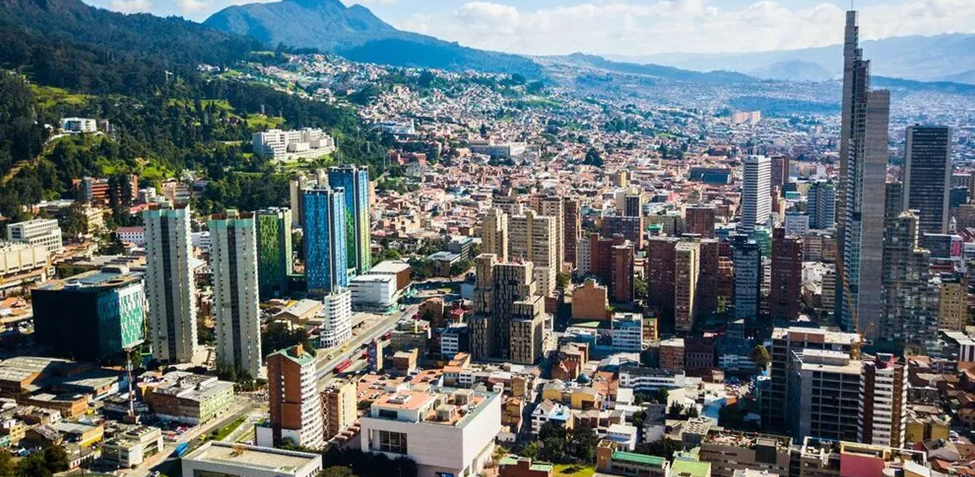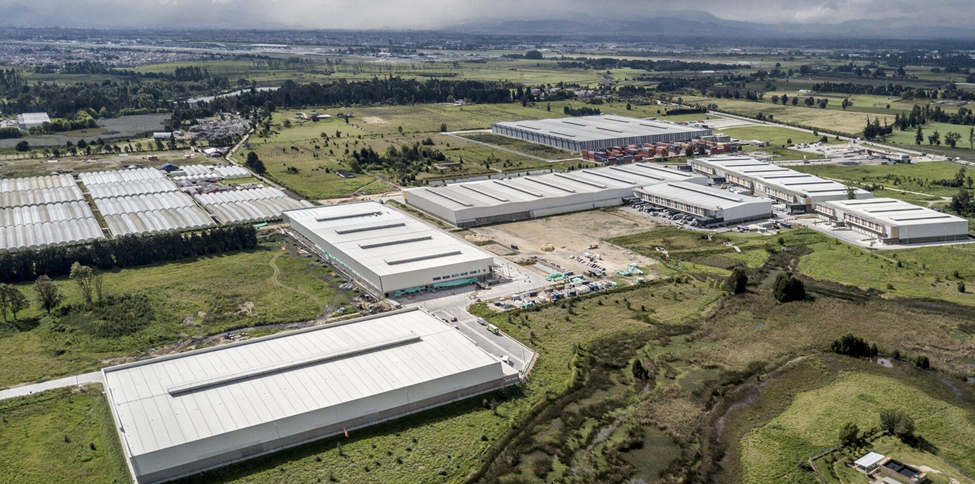Despite Exceptional Growth, New President’s Agenda Dims Investor Sentiment

Executive Summary
Colombia has the highest GDP growth in the Americas, its commercial real estate is performing well, and its residential real estate has record sales. The main drivers of real estate growth - population growth, working age population growth, household formation – all are strong. However, Colombia is vulnerable to international monetary policy fluctuations and has a new government with a still uncertain (possibly investor-unfriendly) agenda. Investors have taken note and widened the political risk premium on Colombia bonds and currencies.
Compared to the current 12.5% yield on 10-year Colombian bonds, unlevered underwriting returns remain around 11%-12% for core properties and 15%-20% for speculative development. El Dorado Capital Advisors believes these returns are satisfactory for local investors at this time. We conclude that a pricing correction, some distressed situations, or a decrease in country risk premium will probably trigger the next wave of international investment.
Economy
Latin America
Global growth is projected to slow from 6.1% in 2021 to 3.2% in 2022 and 2.9% in 2023. Due to war-induced reshuffling of commodity suppliers, emerging markets that are net energy/food exporters have seen their 2023-2027 prospects improve. Colombia is expected to outperform many of its emerging market peers and developed markets in general. However, the stronger US dollar has dampened foreign investment in the region, and internal political events have increased uncertainty.
LatAm countries are not a homogeneous bunch – each has their particular economic drivers and challenges, and overall, the interdependence of the economies is less significant than, say, in the EU. Consequently, individual country forecasts are unequal. For 2022, Colombia (6.9%) will outpace all its regional peers - Peru (2.6%), Chile (2.1%), Brazil (1.7%) and Mexico (1.7%). However, the relative weights of the Brazil and Mexican economies bring down the headline growth of the region to 3.0%.
The LatAm region, like the rest of the global economy, has experienced a sharp rise in inflation as economies rebounded. Now, many LatAm countries have inflation higher than the upper range of their respective inflation targets. However, most of the region's largest economies are well along in their monetary policy cycles, so relative to developed markets, monetary policy positioning is actually at multiyear highs in terms of both nominal and real interest rates. Inflation is expected to return to ±3.0% within three years.
Increased political uncertainty in China has many firms in the United States rethinking their dependence on Chinese factories. Hence, LatAm has another opportunity in nearshoring/ friendshoring if it can improve its shipping infrastructure and liberalize its trade policies.
Political discontent, which had been simmering for several years before COVID, has become more widespread. After President Andrés Manuel López Obrador's election in Mexico in 2018, leading Latin American countries saw a political shift that favored relative outsiders advocating for radical changes – a shift away from growth towards reducing inequality. However, mitigating factors include 1) promised fiscal prudence, 2) strong democratic institutions and 3) weak mandates that limits deep reforms.
Countries with high current account deficits, such as Chile and Colombia, are more exposed to a longer period of high global interest rates, creating tighter liquidity conditions, but the foreign-exchange reserve levels in these countries are ample. What's more, these nations enjoy access to financing from foreign private and multilateral organizations, which reduces the risk that a sudden halt in external financing will evolve into a deeper economic crisis.
The aggressive tightening by Latin American central banks will likely push real interest rates back into positive territory for much of the region, boosting the relative attractiveness of Latin American assets. Moreover, following steep selloffs in 2020 and 2021, most of the region’s currencies are undervalued according to measures of real effective exchange rates, which should further entice international investors.
Colombia

Colombia’s real GDP grew by 12.6% in Q2 2022, outperforming all other global economies. The solid growth reflects the positive response of the economy to the total relaxation of mobility restrictions and the return to in-person activities. Looking ahead, expect a moderate slowdown in consumption to more sustainable levels in the second half of 2022. Consensus 2023 growth is 2.3%.
Colombia has not been immune to global inflationary pressures with June 2022 inflation at 10.2%, well above BanRep’s target range (2%–4%) for the 22nd month in a row. Consensus inflation expectations have increased to 11.4% in 2022 and 9.4% in 2023.
The central bank raised its benchmark interest rate by 100bps to 9.0% in July 2022. The consensus expectation is for the Central Bank to continue raising rates before peaking at 10.5% by the end of 2022 and finishing 2023 at 9.0%.
Covid-19 resulted in most economies increasing their Debt-to-GDP levels by 10-20%. Colombia’s Debt-to-GDP, which reached 66% in 2020, will be among only a handful of countries, and the only one in Latin America, whose Debt-to-GDP will be lower in 2027 (52%) than pre-pandemic.
Among LatAm nations, Colombia has a particularly compelling opportunity in nearshoring/ friendshoring of supply-chains. To date, this has manifested itself in strong services growth, primarily in IT and business process outsourcing (BPOs) which has lent strength to the office market.
However, due to higher-than-normal political risk and structural vulnerabilities to international monetary policy movements, 10-year bond spreads remain around 550 bps wider than before COVID.
Colombia began a new political chapter with the inauguration of Gustavo Petro, the country’s first-ever leftist president and a former guerilla. Having campaigned on a radical agenda to redistribute wealth, execute rural land reform, end the war on drugs and reduce oil dependence, Petro is looking to break with the country’s conservative politics.
But Petro had to cobble together a broad coalition to obtain a governing majority in Congress. The risk of radicalization or of concentrating political power does not seem significant at this stage. Rather, Petro’s presidency will likely be marked by a movement in the direction towards a more equal society rather than a full-scale revolution.
Since winning the election, Petro has also sought to assuage fears that he would govern as a radical by appointing respected candidates for key ministerial jobs. He has signalled that he wants to shift the Colombian economy more towards a western European form of capitalism rather than a Cuba/Venezuela form of socialism.
While few of his policies have been articulated, his first step has been a tax reform aimed at collecting more taxes from the rich. The potential impact on investors includes higher capital gains tax (from 10% to 30%), higher dividend taxes (from 10% to 20%), a new 1% equity tax and the elimination of some tax exemptions. Some of the changes may be grandfathered and/or blocked by tax treaties and will require congressional approval.
rEal estate
Residential

YTD 2022, national residential pre-sales were up 0.5%, 1% for VIS and -2% for Non-VIS. However, the surge of pre-sales that began in September 2020 began to reverse in June with pre-sales down 12% vs 2021 and in July 25% down vs 2021. Pre-sales should now be returning to their pre-Covid levels.
Pre-sales are largely driven by subsidy programs. It is uncertain whether these programs will change with the newly elected president.
Mortgage rates have increased 300 bps since mid-2021 and at 13.5%, are nearly 100 bps higher than pre-Covid. Expect cancelations to increase from their current level of 20% as many purchasers are no longer able to qualify for mortgages when their units are delivered.
El Dorado Capital Advisors is doubtful that much of the higher-than-average pre-sales in 2021 (227,000) will ever be converted to actual sales (pre-COVID pre-sales were around 160,000 pa). We believe that many projects will be delayed and/or aborted.
Since the COVID surge in sales, banks have tightened their lending standards to both developers and purchasers. In fact, outstanding development debt has decreased slightly.
However, these financing limitations have acted to self-regulate the market and prevent overbuilding. Since April 2020, completed inventory has declined 47%. The AMT expects late-stage projects to benefit as purchasers are motivated to acquire finished product before subsidy programs run out.
The demand for housing remains very strong. Colombia currently has a 3.5M unit housing deficit. With household formation averaging 340,000 per year while housing development can produce 180,000 units per year, the deficit continues to widen. While 45% of Colombian’s rent, nearly all new supply and subsidies are geared towards condo development.
Colombia residential real estate has not yet benefitted from the cycle of declining mortgage rates that have fueled so much price appreciation in developed markets.
Currently, there may be opportunities to:
Invest in viable projects from smaller developers that are being held back due to a lack of financing.
Provide liquidation mechanisms for unsold inventory at the completion of projects.
Recapitalize developers or provide alternative development financing options as the current amount of capital is insufficient to meet demand.
Establish a residential rental platform.
Office

Overall, office vacancies have not spiked significantly post-COVID. In fact, net absorption has been positive and rental rates are stable. Current vacancy rates in Bogota and Medellin are 11.7% and 6.2%, respectively. The office market has been helped by a growing presence of BPO tenants.
The leasing of newly developed buildings has been more difficult. Fortunately, the production of new space for delivery in 2020-2024 was already low before COVID.
There has been speculation that the new President will raise property taxes. Since leases are semi-gross (landlord responsible for property taxes), this could flow through to the landlord’s bottom line.
Office cap rates remain unchanged at 7.5-8.5%.
Most office tenants have long-term leases with contractual annual rent escalations (>CPI). Tenants generally pay their own improvements.
Retail

Overall, vacancy remains low and absorption is positive. However, there has been some softening of rental rates. Current vacancy rates in Bogota and Medellin are 6.9% and 4.5%, respectively. The retail market has been helped by a strong retail growth, up 17.2% y/y in June 2022.
Contrary to North America where shopping centers serve an essentially utilitarian function, modern Colombian retail malls have in fact become part of the social fabric that serves a community function much like the old town squares used to decades ago. Expect resiliency from this asset class.
Office cap rates remain unchanged at 7.5-8.5%.
Most retail tenants have long-term leases with contractual annual rent escalations (>CPI).
Tenants generally pay their own improvements.
Industrial

The industrial market is performing very well with low vacancy, positive absorption and increasing rental rates. Current vacancy rates in Bogota and Medellin are 3.7% and 8.2% respectively.
Most industrial tenants have long-term leases with contractual annual rent escalations (>CPI). Tenants generally pay their own improvements.
Overall, the Colombian real estate market continues to demonstrate resiliency in 2022 and we expect that to continue going forward. The market has been disciplined and has avoided overbuilding. We do not see Colombia real estate succumbing as much to some of the macro trends impacting real estate in the developed world such as work-from-home and e-commerce.
However, real estate valuation has not incorporated the 550bps increase in 10-year bond yields. Local market participants may see these external fluctuations as noise (they have happened before; they will happen again) and not impactful on the long-term value of real estate. From an international investor's perspective, the floor on pricing should be reassuring, however, by not incorporating these risks into pricing, the relative value proposition for Colombian real estate is not attractive (for now). There may be opportunities for international investors who see these risks as overstated and anticipate political risks abating, currency returning to its fundamental value and credit rating restored to investment grade.

Comments